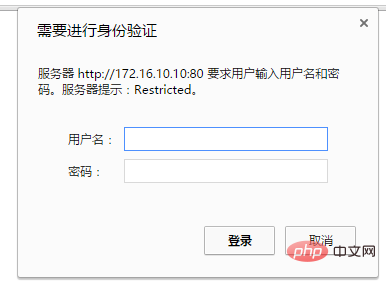Nginx怎么实现浏览器可实时查看访问日志
一、首先查看nginx版本,我使用的是1.9.7的版本,安装目录在/application/nginx-1.9.7
[root@ansheng ~]# /application/nginx-1.9.7/sbin/nginx -v nginx version: nginx/1.9.7 built by gcc 4.4.7 20120313 (red hat 4.4.7-16) (gcc) configure arguments: --prefix=/application/nginx-1.9.7 --user=nginx --group=nginx --with-http_stub_status_module
二、检查语法并启动nginx
[root@ansheng ~]# /application/nginx-1.9.7/sbin/nginx -t nginx: the configuration file /application/nginx-1.9.7/conf/nginx.conf syntax is ok nginx: configuration file /application/nginx-1.9.7/conf/nginx.conf test is successful [root@ansheng ~]# /application/nginx-1.9.7/sbin/nginx
三、把nginx配置文件内多余的注视行和空行删掉
[root@ansheng ~]# cd /application/nginx-1.9.7/conf/
[root@ansheng conf]# egrep -v "#|^$" nginx.conf.default
worker_processes 1;
events {
worker_connections 1024;
}
http {
include mime.types;
default_type application/octet-stream;
sendfile on;
keepalive_timeout 65;
server {
listen 80;
server_name localhost;
location / {
root html;
index index.html index.htm;
}
error_page 500 502 503 504 /50x.html;
location = /50x.html {
root html;
}
}
}
[root@ansheng conf]# egrep -v "#|^$" nginx.conf.default nginx.conf四、在nginx配置文件的server标签内加入以下标签和内容
location /logs {
alias /application/nginx-1.9.7/logs;
#nginx日志目录
autoindex on;
#打开目录浏览功能
autoindex_exact_size off;
#默认为on,显示出文件的确切大小,单位是bytes
#显示出文件的大概大小,单位是kb或者mb或者gb
autoindex_localtime on;
#默认为off,显示的文件时间为gmt时间。
#改为on后,显示的文件时间为文件的服务器时间
add_header cache-control no-store;
#让浏览器不保存临时文件
}五、开启在浏览器打开log文件,如果不开启再点击文件的时候就下载而不是打开
[root@ansheng conf]# vim mime.types
types {
text/html html htm shtml;
text/log log;
text/css css;
text/xml xml;
.............六、检测语法,然后让nginx配置生效,在浏览器查看
[root@ansheng conf]# /application/nginx-1.9.7/sbin/nginx -t nginx: the configuration file /application/nginx-1.9.7/conf/nginx.conf syntax is ok nginx: configuration file /application/nginx-1.9.7/conf/nginx.conf test is successful [root@ansheng conf]# /application/nginx-1.9.7/sbin/nginx -s reload
打开浏览器输入域名或者ip,后面加上logs,然后点击文件就可以打开了,如果日志随随便便就可以被别人查看是不是很不安全,所以我们要在加一层nginx用户认证。


七、安装httpd-tools,用于帐号密码生成
[root@ansheng ~]# yum -y install httpd-tools
八、创建认证的账号
[root@ansheng ~]# htpasswd -c /application/nginx-1.9.7/conf/loguser loguser new password: re-type new password: adding password for user loguser #密码需要输入两次
九、编辑nginx配置文件,在logs的location加入下面的内容
location /logs {
......
alias path;
autoindex on;
autoindex_exact_size off;
autoindex_localtime on;
add_header cache-control no-store;
auth_basic "restricted";
#nginx认证
auth_basic_user_file /application/nginx-1.9.7/conf/loguser;
#认证账号密码保存的文件
}十、然后再打开的时候就会提示输入账号和密码,登陆之后才可以查看。

以上是Nginx怎么实现浏览器可实时查看访问日志的详细内容。更多信息请关注PHP中文网其他相关文章!

热AI工具

Undresser.AI Undress
人工智能驱动的应用程序,用于创建逼真的裸体照片

AI Clothes Remover
用于从照片中去除衣服的在线人工智能工具。

Undress AI Tool
免费脱衣服图片

Clothoff.io
AI脱衣机

AI Hentai Generator
免费生成ai无尽的。

热门文章

热工具

记事本++7.3.1
好用且免费的代码编辑器

SublimeText3汉化版
中文版,非常好用

禅工作室 13.0.1
功能强大的PHP集成开发环境

Dreamweaver CS6
视觉化网页开发工具

SublimeText3 Mac版
神级代码编辑软件(SublimeText3)

热门话题
 linux怎么启动nginx
Apr 14, 2025 pm 12:51 PM
linux怎么启动nginx
Apr 14, 2025 pm 12:51 PM
在 Linux 中启动 Nginx 的步骤:检查 Nginx 是否已安装。使用 systemctl start nginx 启动 Nginx 服务。使用 systemctl enable nginx 启用在系统启动时自动启动 Nginx。使用 systemctl status nginx 验证启动是否成功。在 Web 浏览器中访问 http://localhost 查看默认欢迎页面。
 nginx在windows中怎么配置
Apr 14, 2025 pm 12:57 PM
nginx在windows中怎么配置
Apr 14, 2025 pm 12:57 PM
如何在 Windows 中配置 Nginx?安装 Nginx 并创建虚拟主机配置。修改主配置文件并包含虚拟主机配置。启动或重新加载 Nginx。测试配置并查看网站。选择性启用 SSL 并配置 SSL 证书。选择性设置防火墙允许 80 和 443 端口流量。
 linux怎么查看nginx是否启动
Apr 14, 2025 pm 12:48 PM
linux怎么查看nginx是否启动
Apr 14, 2025 pm 12:48 PM
在 Linux 中,使用以下命令检查 Nginx 是否已启动:systemctl status nginx根据命令输出进行判断:如果显示 "Active: active (running)",则 Nginx 已启动。如果显示 "Active: inactive (dead)",则 Nginx 已停止。
 怎么查看nginx是否启动
Apr 14, 2025 pm 01:03 PM
怎么查看nginx是否启动
Apr 14, 2025 pm 01:03 PM
确认 Nginx 是否启动的方法:1. 使用命令行:systemctl status nginx(Linux/Unix)、netstat -ano | findstr 80(Windows);2. 检查端口 80 是否开放;3. 查看系统日志中 Nginx 启动消息;4. 使用第三方工具,如 Nagios、Zabbix、Icinga。
 nginx403怎么解决
Apr 14, 2025 am 10:33 AM
nginx403怎么解决
Apr 14, 2025 am 10:33 AM
如何解决 Nginx 403 Forbidden 错误?检查文件或目录权限;2. 检查 .htaccess 文件;3. 检查 Nginx 配置文件;4. 重启 Nginx。其他可能原因还包括防火墙规则、SELinux 设置或应用程序问题。
 怎么启动nginx服务器
Apr 14, 2025 pm 12:27 PM
怎么启动nginx服务器
Apr 14, 2025 pm 12:27 PM
启动 Nginx 服务器需要按照不同操作系统采取不同的步骤:Linux/Unix 系统:安装 Nginx 软件包(例如使用 apt-get 或 yum)。使用 systemctl 启动 Nginx 服务(例如 sudo systemctl start nginx)。Windows 系统:下载并安装 Windows 二进制文件。使用 nginx.exe 可执行文件启动 Nginx(例如 nginx.exe -c conf\nginx.conf)。无论使用哪种操作系统,您都可以通过访问服务器 IP
 nginx304错误怎么解决
Apr 14, 2025 pm 12:45 PM
nginx304错误怎么解决
Apr 14, 2025 pm 12:45 PM
问题的答案:304 Not Modified 错误表示浏览器已缓存客户端请求的最新资源版本。解决方案:1. 清除浏览器缓存;2. 禁用浏览器缓存;3. 配置 Nginx 允许客户端缓存;4. 检查文件权限;5. 检查文件哈希;6. 禁用 CDN 或反向代理缓存;7. 重启 Nginx。
 nginx403错误怎么解决
Apr 14, 2025 pm 12:54 PM
nginx403错误怎么解决
Apr 14, 2025 pm 12:54 PM
服务器无权访问所请求的资源,导致 nginx 403 错误。解决方法包括:检查文件权限。检查 .htaccess 配置。检查 nginx 配置。配置 SELinux 权限。检查防火墙规则。排除其他原因,如浏览器问题、服务器故障或其他可能的错误。






